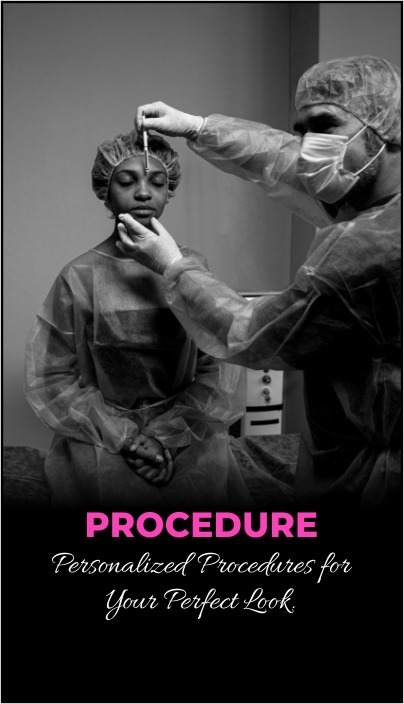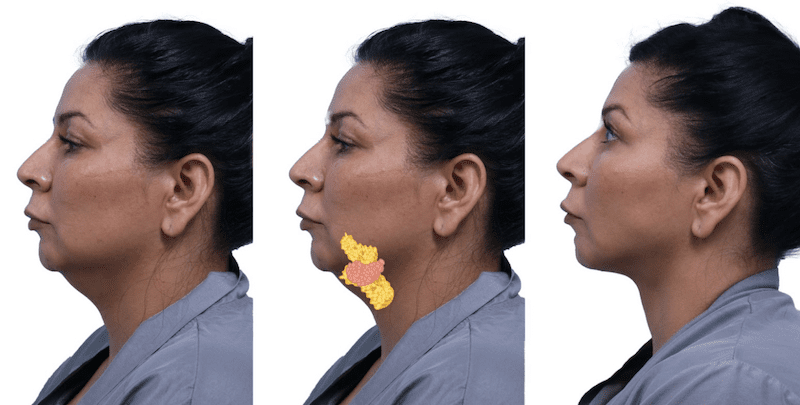

What is a neck lift?
A neck lift is designed to address loose skin, excess fat, and/or loose muscle in the neck area. The neck tends to be one of the earliest areas of the face to show aging, and recreating that youthful neckline can have a dramatic effect on facial appearance.
This procedure can be done several ways depending on the degree of aging, either by a small incision under the chin or incisions in front of and behind the ear. That choice can be made between the patient and surgeon through a consultation.
For best results, choose a surgeon with significant experience in cosmetic surgery. Ask your surgeon about their credentials, training, and how many similar procedures they’ve performed.

Aging of the neck is usually a combination of loose skin and muscle and some excess fat. This combination results in the so-called “turkey gobbler.” There are many approaches that can be used to address the neck alone or in combination with the jowl and cheek area. This decision is best made in consultation with your surgeon. The typical age of a patient to receive this procedure is between 30 and 70 years (or older).
Good candidates for neck lift surgery include:
For a neck lift through a chin incision, skin quality may significantly affect the degree of profile improvement. So, good candidates for neck lift through a chin incision surgery include:
People with more significant skin aging can be treated by skin removal under the chin or by incisions made in front of and behind the ear.
Preparing for your neck lift surgery at Cleveland Clinic Cosmetic & Plastic Surgery Center will include discussing a few questions about your health, desires, and lifestyle with your plastic surgeon. They’ll evaluate your general health status and any preexisting health conditions or risk factors as part of a consultation.
To ensure the best results from your neck lift procedure, be prepared to discuss:
Your plastic surgeon will also:
Your surgeon can perform neck lift surgery in a variety of ways:
All surgical procedures carry some risk. Possible complications from neck lift surgery include:
The results of neck lift surgery (chin lift) are visible almost immediately. However, it may take several months for all subtle swelling to subside and for the final results to become apparent. Scars from this procedure may be small, thanks to the minimally invasive approach. Overall results are generally long-lasting. View our neck lift before-and-after photos to see results from actual patients.
Recovery from a neck lift takes time, and it’s important to be patient. Most people can return to work within seven to 14 days. If you are physically active or participate in sports, you will need to wait at least two to three weeks before resuming those activities, depending on the extent of the procedure.
Your surgeon may recommend wearing a medical compression bandage to help reduce postoperative swelling. This is typically worn night and day for five to seven days and then only at night for a longer period. It's crucial to follow the post-operative instructions to ensure proper recovery.
A neck lift is a relatively simple aesthetic procedure that can smooth your skin, tighten tissues and muscle, and, when necessary, remove excess skin and fat from the neck. This can help you look and feel younger. It’s an effective way to get rid of excess fat and skin around the chin, jawline, and neck with minimal risk. A neck lift may be performed alone or in conjunction with a facelift. There are various surgical and non-surgical techniques, including limited facelift techniques, submentoplasty, liposuction, and Kybella injections.
Candidates for a neck lift fall into two categories. The first group includes young or middle-aged patients who have congenital or acquired deposits of fat under the chin and jawlines. The second category is patients who develop excess skin laxity, fat, or muscle in the neck area as they age. Those with good skin elasticity and excess fat may be candidates for less invasive procedures, while those with more extensive sagging may require a more traditional neck lift.
The procedure depends on the type of neck lift. In surgical procedures, anesthesia is administered, and incisions are made to reposition fat, muscle, and tissue. Liposuction may also be performed. Non-surgical methods, such as Kybella, involve multiple sessions of injectable treatments over several months.
Post-operative care involves managing swelling and bruising. Elevating the head and wearing a compressive garment for the first week is recommended. Discomfort is mild to moderate and can be managed with medication. For surgical procedures, results are seen immediately, while non-surgical methods may take months.
Although a neck lift is a common and safe procedure, there are risks, including infection, bleeding, bruising, swelling, numbness, and skin contour irregularities. However, the results, such as a more youthful appearance, help restore confidence and typically outweigh the risks.
The total cost of neck lift surgery is based on factors such as medical examinations, surgeon’s fees, hospital charges, post-surgery garments, and anesthesia. The techniques used and the time needed to perform the surgery also affect the overall cost.
